|
|
|
|
|
|
|
|
|
|
|
|
|
|
|
|
|
|
||||||
|
|
|
|||||
Amateur radio is fascinating hobby which enables millions
worldwide to communicate with each other by many different means. Amateur radio
is a hobby for everyone interested in communicating…
Amateur radio is responsible for putting hundreds of
thousands of poeple all over the world into direct contact with each other
every day.
World wide there are two million
licensed radio enthusiasts spread across virtualy every country, who are free
to operate from the comfort of their own homes.
Age, profession, nationality,
political and ethnic barriers are non existent, thus promoting international
friendship and understanding. Amateur radio can be enjoyed by young and old,
male and female and even the most severely disabled can make friends around the
world from their own home.
Contacts may be made using Morse
code ( telegraphy mode) or speech, between computers and even by television.
Radio amateurs have built satellites for their own use.
Because radio amateurs are
permitted to use a wide range of frequencies and transmission modes, they must
be qualified operators. Training is available from radio clubs or technical
colleges, depending on the qualification needed. A novice licence scheme
available in many countries provides an easy way to become a radio amateur.
Amateur radio can be enjoyed in many different ways. Some
of the ways in which you can enjoy this interest are:
Telegraphy contact ( CW ) using the Morse code – using a series of dots and dashes transmission can reach further
distances than speech. It is also an international ”language” allowing contacts
all over the world.
Voice contact – using the microphone linked to a
transmitter / receiver.
Satellite transmission – international
contacts are possible by bouncing communications off satellites orbiting the
earth. Radio amateurs take an active part in designing and building satellites
for their own use.
DX peditions – an amateur radio trip. This can be
anywhere from the North Pole to remote unheard of islands, to your foreign
holiday, or remote uncharted jungles.
(thanks to RSGB web pages)
Next pages are devoted exclusively to
Amateur radio. You may find here some stuff concerning CW, operating and
technical news. I am trying to keep this page as interesting as possible, so no
boring personal data included.
I'am member of a few CW clubs
and fun-groups & there are links …

There are some basic informations
about my favourable QRP equipments for HF backpacking operations…

MIZUHO HF CW/SSB HANDHELD
QRP
TRANSCEIVERS from Japan.
Do you know
MIZUHO ?
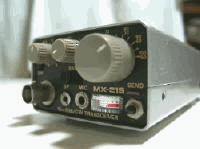
MX-21S, 2W SSB/CW Transceiver…
I purchased my first MX-21S
as a used radio in 2002.
This is first QRP rig
from Mizuho, Japan for me and till now working excellently.
It was assembled product
in Mizuho, but there was possibility to buy the Kit also,
where PCB completed with
all components and adjustments ready for wiring the switches
and buttons only. ( Not
available now )
NB2(noise blanker) is
option item but Kit model was in-expenssive.
I was enjoyed during many
QSOs with MX-21S.
In CW mode, it is not
difficult to make QSO with many DX stations on 15m when a bit solid antenna is
used !
|
|
|
|
From the MIZUHO
history …
If there is one Mizuho radio
most QRPers are familiar with it's probably the MX series SSB/CW HF handhelds,
though not everyone knows them by that name. The two watt HF and one watt VHF
versions introduced in 1983 are still in production. The series celebrated it's
20th anniversary in 2001, making the Mizuho MX series handhelds probably the
rigs which lasted longest on the market of any ham transceivers ever produced,
and they are still going strong. If you don't know them under the Mizuho name,
perhaps you've seen them as the AEA DX-Handy, or with the Pico brand name, or
with Santec's JIM nameplate. Models have been made for every band from 80m up
through 2m including 12m and 17m. Only 30m has been excluded. The MX series
remain popular with QRPers the world over.
The first of the
series released
was the MX-6 a 250mW 6M SSB/CW transceiver which ran on a single nine volt
battery, was released in Japan in October of 1981. In August, 1982, an improved
version, the MX-6Z, was released, and was quickly followed by a 200mW 2M
version (model MX-2) and a 300mW 15M version (model MX-15): the first Mizuho HF
handheld - MX-6. 10 meters was added to this series in August of 1983 with the
300mW MX-10Z. Note that all the models after the MX-6 added a noise blanker and
replaced the second antenna jack and the phone jack with a more traditional
speaker/mic. arrangement. The MX-10Z and later production MX-6Zs also used six
AAA batteries in place of the nine volt batteries. The milliwatt Mizuho
handhelds were successful despite the miniscule power output. They, like most
Mizuho products, were sold both as kits and as built and tested radios. The
200-300mW Mizuho rigs, along with the better known one and two watt rigs, were
initially distributed in the United States by Ace Communications or Irvine, CA.
Accessories for the early versions of the MX series rigs are now hard to come
by. Many of the accessories currently made simply do not fit or work with the
early rigs.
In May, 1983 Mizuho broke
new ground for the series with the release of the MX-6S. This radio has been in
production ever since, and almost all subsequent Mizuho HTs are based on this
model. The MX-6S spoted many new features: a full watt of output power, an S/RF
meter, RIT, a charging circuit for NiCad (or later NiMH) batteries, and later an
RF attenuator was added as well. The volume control was moved to the top of the
rig as another rotary knob, and the latching PTT switch found on the milliwatt
versions of the rigs was replaced by a more conventional momentary switch. The
mode switch was shifted to the bottom of the rig. The MX-6S proved immensely
popular, and was quickly joined by the MX-7S for 40 meters and the MX-21S for
15 meters. Mizuho now had handhelds for the three Japanese novice bands.
The line was gradually
expanded to include models for all the remaining HF bands except 30 meters.
Additionally, Mizuho introduced a number of accessories, including the CW-2S
sidetone/QSK unit and a series of 10 watt amplifiers. A mounting bracket to
contain the entire "system" and, in effect, create a mini mobile
monoband HF station was released.
In the mid '80s Ace
Communications sold most of the Mizuho line in the United States under the
Mizuho name. After they disappeared, AEA picked up the MX-6S and MX-28S (2
watts on 10 meters) and marketed them as the AEA DX-Handy. By 1993 jCom had
picked up the line and sold the MX series as their Pico transceivers. When jCom
went out of business Ramsey Electronics bought out and sold off their remaining
stock but did not continue to import Mizuho products. Mizuho equipment has not
been distributed or sold commercially in the United States or Canada since the
mid 1990s.
(Thanks to Caitlyn
Martin, KU4QD)
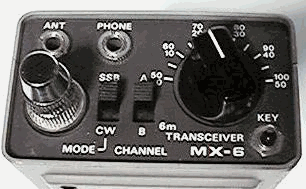
…the first of the series released
was the MX-6 a 250mW 6M SSB/CW transceiver…
Models of Mizuho QRP
Transceivers Available
------------------------------------------------------
MX-3.5S: 80 Meter Band 25Kc. per
XTAL
MX-7S : 40 Meter Band 25Kc. per
XTAL
MX-14S : 20 Meter Band 50Kc. per
XTAL
MX-18S : 17 Meter Band 50Kc. per
XTAL
MX-21S : 15 Meter Band 50Kc. per
XTAL
MX-28S : 10 Meter Band 50Kc. per
XTAL
MX-6S : 6 Meter Band 50Kc. per
XTAL
Please note that each radio will
take a maximum of two crystals at
any one time.It is a simple task
to change crystals as they just plug
in the transceiver underneath the
cover. ( no other adjustment
needed)
GENERAL SPECIFICATIONS OF
TRANSCEIVERS
---------------------------------------------------------------------
Construction : Metal case
throughout
Frequency ranges:
-------------------------
MX-3.5S : 3.500-4.000 Modes LSB/CW
MX-7S : 7.000-7.300 Modes LSB/CW
MX-14S : 14.000-14.350 ModesUSB/CW
MX-18S : 18.068-18.168 Modes
USB/CW
MX-21S : 21.000-21.450 ModesUSB/CW
MX-28S : 28.000-28.600 Modes
USB/CW
MX-6S : 50.000-52.000 Modes SSB/CW
Semiconductors:
---------------------
4 ICs, 13Trs., 6FETs & 37
Diodes
Power supply voltages:
------------------------------
Internal 8.4-9VDC
6X AA drycells
7X Nicads.
When using drycells use supplied
dummy battery.
External 9.5VDC
Do not put 12V directly into the
rig unless using optional DC/DC
converter or charging internal
nicads !!!
Power consumption:
--------------------------
RX 70mA ( at no signal)
TX 620mA (maximum)
Frequency stability:
--------------------------
+/- 500Hz At power-up
+/-100Hz at 25 deg. C after 30
Min.
Antenna impedance : 50 Ohms
Dimensions : 2.6" x 1.5" x 5.6"
Weight (including Batt.) :
MX-3.5S 645g.
all others 590g.
TRANSMITTER SPECIFICATIONS
---------------------------------------------------
Maximum power output : 2 Watts
(1 watt MX-6S 6 meters)
Spurious radiation: -40db
Modulation: Single sideband (suppressed carrier)
Carrier suppression: 40db minimum
Crystal filter sideband
suppression: 40 db minimum
Harmonic Levels:
====================
2nd -63dBc
3nd -59dBc
4th -76dBc
5th <-90dBc
6th -82dBc
7th -80dBc
8th <-90dBc
9th <-90dBc
Built in microphone, LED transmit
indicator and mini CW key-button on
top panel
RECEIVER SPECIFICATIONS
--------------------------------------------
Receiver method: Single conversion superhet
Sensitivity: S/N 15db at 0.5uV input : Attenuator in
0.22uV
Selectivity: -6dB 2.39kHz : -60db 4.55kHz
Blocking: Measured as increase over 12dB SINAD
level of interfering
signal with an unmodulated
carrier, causing 6dB degradation in 12dB
SINAD on-channel signal:
Separation Rejection
=====================================
+/- 10kHz 72.5dB
+/- 100khZ 76.0dB
+/- 1Mhz 91dB
+/- 10MHz 93.5dB
IF and Image Rejection: Increase in level of signals at the first
i.f. image frequency, and at the
i.f. it self (11.2735), over level
of on-channel signal to give
identical 12db SINAD signals:
Image <100dB
IF 73dB
3rd Order Intermodulation
Rejection: increase over12dB SINAD level
of two interfering signals
giving identical 12dB SINAD on-channel 3rd
order intermodulation Product,
10KHz signal spacing:
Attenuator Out 53.0dB
Attenuator In 60.5dB
Intermediate frequency: 11.2735 MHz
RX Includes: Crystal filter, AGC, noise blanker, built
in S-meter
LOCAL OSCILLATOR
-------------------------------
Oscillation method:
Variable crystal
CRYSTAL SPECIFICATIONS
----------------------------------------
For MX-28S:
Funamental mode
60 pF internal capacitance
0.0010 % tolerance
HC-25 case
CONTROLS
-----------------

Top panel: Rit. , AF volume, Tuning, Noise blanker,
Crystal switch,
S-meter, External Speaker and
Microphone jack, mini CW key-button, BNC
antenna jack.
|
|
|
Bottom panel: Power supply in, Charging switch, RF
Attenuator, SSB/CW
mode switch, Jack for external
key.
Optional Mizuho Accessories
-------------------------------------
Telescopic whip antenna
AN-..series, CW side-tone unit CW-2S, 10 Watt linear PL-.. series
amplifier, AC power supply, DC-DC
converter PM-1, Carrying case, speaker mike, Mobile
rack.
Official Mizuho representative:
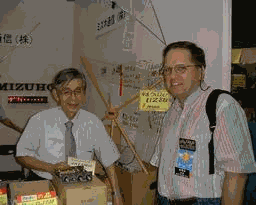
With JA1AMH, Mr.Takada-san of
Mizuho, who is standing behind their new small KX-QRP
wide-range antenna tuner. (Thanks to
JA1CQT for the photo.)
Currently available Mizuho QRP gears …
We are not related MIZUHO
company at all.These are currently
available MIZUHO QRP
products list with my comments here
just as an information to
foreign QRP friends. You can purchase
them 10-15% off at
amateur radio retailers in Tokyo ($1=YEN125.).
Transceiver(We call
them Pico series):
MX-6S 32,000yen 50MHz
SSB/CW 1W
MX-7S 32,000yen 7MHz
SSB/CW 2W
MX-21S 32,000yen 21MHz
SSB/CW 2W
PL-6S 21,600yen 50MHz
Linear 10W
PL-7S 21,600yen 7MHz
Linear 10W
PL-21S 21,600yen 21MHz
Linear 10W
Comments: The smallest CW/SSB transceiver
in the world.
S/RF meter,
Noise-branker, Attenuator installed handy
talky type QRP rig. VXO
A/B channel selection of each
50Khz(below 7MHz:25KHz)
coverage. IF is 11MHz.11Tr 3IC.
The company sporadically make
3.5,14,18,28MHz version.
It is very difficult to
buy them because many amateur
want to have it. Now only
completed Pico transceiver
is supplied. I suppose
many failed to complete kit and
troubled company.
Options for Pico:
PM1 3,300yen DC-DC
converter
MS-1 4,600yen SpeakerMic
PR3-S 4,500yen Lack mount
(MX,CW-2S,PL)
CW-2S 8,400yen CW
semi-break-in unit /w sidetone
BM-6 1,500yen lather bag
PS-2 3,600yen AC adapter
Crystal 1,800yen any
desired 25/50Khz band
PAN-62 5,200yen pocket
dipole 50/144
AN-50 3,600yen 50MHz lod
antenna
AN-7 4,800yen 7MHz lod
antenna
AN-21 4,800yen 21MHz lod
antenna
Comments: Pico need 9V power (AAA battery x
6). Feeding
12V will destroy the
unit. I think the DC-DC is expensive
you can make 9V with 7808
and one Di between the GND.
CW-2S is recommended for
CW operation.
Kits and misc.:
QP-21 3,000yen 21MHz 1W
CW transmitter
QP-7 3,000yen 7MHz 1W CW
transmitter
CK-1D 9,000yen Currtis
Electric keyer
VFO-5D 6,000yen stable
5-5.5M VFO module
VFO-5D 6,000yen stable
7-7.1M VFO module
MA-1 1,300yen audio amp
module
MA-20A 2,000yen Mic amp
module
PF-1A 2,500yen CW peak
filter module
KX-50K 8,000yen 50MHz
antenna coupler
Comments: QP series are the most famous kit
with fixed crystal.
It does not change the
price more than 10 years. The VFOs are
sealed module with iron
case.Japanese QRPer use this unit to
avoid difficult unstable
VFO problem which annoys other station.
"MIZUHO"
means beautiful riceplant. The owner JA1AMH Mr.Takada
named
his company as he wish everyone to remember the beautiful
country
and free quiet life with his QRP radio goods in this
busy
world.
I am no relation with
MIZUHO. Just a user enjoy MIZUHO.
( Thanks to Junichi
Nakajima / JL1KRA )
So,
I hope that answers any questions you may have about the rigs…
My
latest QRP QSOs with MIZUHO MX-21S… (updated 21/7/2003)
IT9, EA6, UN8, OY (
I heard P29, YB0 and also YC7 from Borneo but no QSO...)
...all with MX-21S Mizuho
tcvr into the 1.7m long mobile whip with magnetic base
on the cars roof connected
thru transmatch, SWR meter and powered by DC-DC
home made adapter from cars
battery.
The best 2-way QSOs
with MX-21S transceiver 1.5W output into the vertical HF6V located in Kostice,
locator JO60XJ, county ELO, Czech Republic :
ZL, W5, 3B8, OX,
YV, TR, PY, 3V8.
Technical
news…
(updated 21/7/2003)
I am working on the user friendly DC-DC
converter for MX-..S series of the MIZUHO handhelds for all of the users they
are need it for external DC power supply operation higher than 10V. Small black
box with simple function, cheap and usable displacement for original equipment
PM-1 from Mizuho. At the moment it is under development and testing.
Latest
DC-DC converter for MX-..S series ver. 1.2. works
great and building is really cheap.
I am preparing small kit of the DC-DC
converter for sale !
I
am still testing the another beta ver. 1.2. Bandpass filter for MX-21S cause last one
had too much insertion loss.
I am also working on simple option
for easily CW operation without necessity to use original CW-2S kit from
Mizuho. I
have arranged very simple kit which makes the same functions as the CW-2S and
works very nice. Now under beta tests...
Latest project is mini PA excited
by Mizuho MX-..S for 100W output power when used in fixed QTH only for $80
only !
Another developments will
be soon !
I am
able to repairing your Mizuho MX..S handhelds from now !
If
you have any troubles with Mizuho (mainly in EU) then contact HOT Line ...
New
HOT Line: Click
here to [email protected] for asking directly if you have any
questions, requests, orders or technical troubles. Thanks. Petr, OK1RP
Japan
MIZUHO handhelds FOR SALE :
A List of
New and Used MIZUHO Radios available in Japan only !!!
Last update 21-7-2003. Copyright
OK1RP & OK1-35506.

Used Handheld HF TCVR MX-21S. 15m CW/SSB/2W,noise blanker,attenuator,
VXO (2x50kHz),S-meter +
W-meter,superhet + 4xtal filter. 2xSSB band xtaled.
Radio is used, but good
conditions and functions, minor scratches only!
Price
is now
in
special…additional discount only for
150,-
USD !!!
Contact [email protected],
00420608230010
Another
equipment from Japan FOR SALE:
NEW ! Mizuho SX-9S QRP tuner.
Specifications: Freq. range: 3-54
MHz. Max. 10W thru power.
Input impedance: 50-600 ohms. Dimensions: 162 x 55 x 130mm
Weight: 800gr
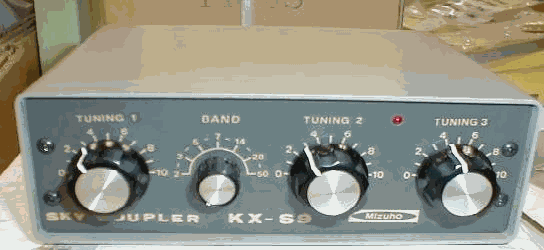
Ideal for FT-817 or Mizuho handhelds
!
Price call for price ( New one ! )
Contact [email protected],
00420608230010.
Mizuho
MX-14S, MX-18S, MX-24S, MX-3.5S discontinued !!!
Only
used ones can be found …
Terms
of Sale:
Payment by International MONEY ORDER / VISA / Eurocard /
Mastercard or CASH
ONLY.
All
prices are NOT including the
shipping/insurance taxes from Czech !!!
Call
for shipping cost which is different according to landing area, approx. 15-30USD.
Conversion to other currencies according to actual rate of exchange in OK. [email protected]
I am
an individual,
not a business! So makes a help with Mizuho gears in EU only.
Will ship only
as a global priority - cheapest way.
!!!
Used items are tested for transmit and receive. But as with all electronic
gear, there
are no warranties implied !!! Click here to [email protected] for
asking directly if you have any questions.
Thanks. Petr,
OK1RP
Items
are shipped next business day after payment arrives !!!
I am
able to repairing your Mizuho MX..S handhelds from now !
If
you have any troubles with Mizuho (mainly in EU) then contact HOT Line ...
New
HOT Line: Click
here to [email protected] for asking directly if you have any questions,
requests, orders or technical troubles. Thanks.
Petr, OK1RP
FOXX-3 - QRP CW TRANSCEIVER kits
for HF
bands from Kanga Products, U.K.
- your home
brew QRP experiment…
( From the kits manufacturer - Kanga
Products, U.K. web pages …)
You may have heard of the Pixie, the VU Mini
and the Micro 80. All of these transceivers use the PA transistor as the
receive mixer, but the original idea came from the UK and the well-known QRPer
George Burt GM3OXX in 1982. It first appeared in SPRAT in 1983.
The FOXX-3 is the latest version of the ever-popular FOXX. Designed by Derek
Alexander, it incorporates a sidetone oscillator, changeover relay and low-pass
filter. It fits inside an Altoids (TM) mint tin and all connections are made
via vertical connectors which are concealed when the lid is closed. The
connections are as follows:
- antenna via 50 ohm BNC,
- power via2.1mm co-axial connector or 2 pin 0.1" header,
- headphones via3.5mm mono or stereo jack plug or 2 pin header,
- Morse key via 3.5mm mono or
stereo jack plug or 2 pin header.
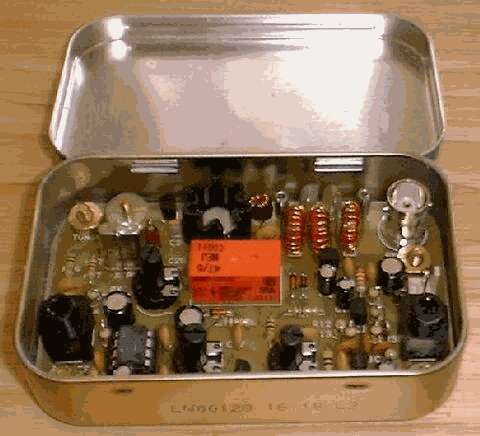
We also supply a small PCB-mounted
switch which can be used as the key for ultimate portability. All you need to
add are a 12 volt DC supply, headphones and an antenna and tuner. The picture
shows the first FOXX-3 built on a production PCB. Note the screen printing
which identifies all component positions. The optional push-switch Morse key is
fitted. Richard Newstead, G3CWI, recently operated a 40m FOXX-3 from the
summits of Snowdon and Scafell Pike, the two highest peaks in Wales and
England, in a single weekend. Despite sub-zero temperatures, Richard made 20
contacts in a total operating time of 80 minutes. Richard told me, "FOXX
performed brilliantly. Sidetone stops at -10 degrees C but radio still seemed
OK." "I didn't build any additional filtering for the FOXX and it worked
really well. No BC breakthrough at all on either day."
Thanks for the info, Richard, but I won't be testing it at -10 C myself.
The FOXX-3 was launched at the Rochdale QRP Mini-Convention on October 28th
2000.
FOXX3 Construction Pictures
The change in ownership of Kanga in the UK
has been accompanied by a change in the documentation in the new kits that are
coming out of Kanga. The pictures below are pictures I took while assembling a
20 meter FOXX3 kit. Although it is hard to tell from the pictures, the
documentation breaks down the construction of the kit into logical stages, and
each stage is tested and working before work starts on the next stage. The 20m
FOXX3 I built and documented in these photos worked at turn on when it was
completed.
The kit comes with each stage in a separate
plastic bag, so there is no sorting parts. Even the parts list in the
documentation is split up by stage.
FOXX3 Construction Pictures
The change in ownership of Kanga in the UK
has been accompanied by a change in the documentation in the new kits that are
coming out of Kanga. The pictures below are pictures I took while assembling a
20 meter FOXX3 kit. Although it is hard to tell from the pictures, the
documentation breaks down the construction of the kit into logical stages, and
each stage is tested and working before work starts on the next stage. The 20m
FOXX3 I built and documented in these photos worked at turn on when it was
completed.

The kit comes with each stage in a separate
plastic bag, so there is no sorting parts. Even the parts list in the
documentation is split up by stage.

The audio stage after completion.

This photo is after the keying stage was added. It also shows the documentation for the construction of the keying stage. You should be able to make out the schematic, parts list, and layout of the keying stage (only) parts. The instructions for this stage are on another page in the documentation.
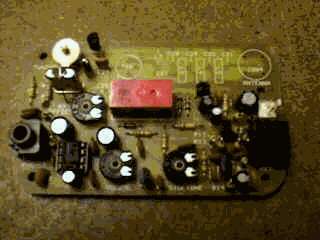
The Oscillator stage is then added....

And finally the output filter is added. One
of the things that is not obvious from the photos is that there are several
connector options supplied with the kit. There are multiple ways of connecting
the key, power, and antenna. All the connectors are supplied, and they all can
be mounted directly on the PC board. All that is left for you to do is put it
in an enclosure. Directions are given for installing the FOXX3 in an Altoids
(or similar) tin.
There
is the comments and experiences with assembling the kit …
( by Jim, W4JBM and myself Petr, OK1RP)
I was impressed
with the quality of the board. There was an omission in the instructions that
came with very early FOXX-3's (installation of capacitor C10). The capacitor
was included, there was a place for it on the board, and it was shown in the
schematic so it wasn't rocket science to figure out I needed to install it.
This omission was corrected in later releases of the kit.
The only problem I
had was the testing after stage 4 (assembly of the crystal oscillator). My
oscillator didn't work through the full VXO range. After some study, I decided
that it would work once the oscillator was loaded by the mixer/PA stage. This
was verified with a temporary load and things worked fine. Once assembly was
complete things worked as expected.
This is an
incredible little rig. Automatic TR switching, a sidetone, VXO, RIT, and can be
powered by a 9 volt battery.
The only weakness
is total gain for the receiver. Usually if they can hear you you'll be okay.
But I use mine with an amplified speaker for more gain. This combination works
great!
I've taken it to
club meetings and ham fests. It never fails to get comments. A couple of
no-code techs have said now they understand why they should bother to learn the
code--something this simple and yet useful.
So if you get the
chance, get the kit and put one together. Maybe I'll see you on the air for a
2-way FOXX-3 QSO!
The
best 2-way QSOs with FOXX-3 transceiver home brewed with 250/500mW power output
into the vertical radiator located in Praha, Czech Republic :
JA9, ZL1, W1, mni
EUs like G, OH, LA, PA, I, 4X4, SM, YU, LZ etc.
Technical
news…
(updated 21/7/2003)
Cause of lots BC
breakthru during the nite operations I am working hard on improvement of the RX
by the enforced filter on the basic board and additional filter in extra
minibox.
From
1st April 2003 I am still testing another beta ver. of "on board"
filter giving min. -55dB on BC freq. Last HPF gives good 40dB attenuation on BC
band but insertion loss is too high. Latest filter works good but its larger
than standard Altoids box...looking for another architecture of the filter or
another box?! J
If
its possible then use as good as possible shielding for filters and self tcvr.
Now under
development and testing…
Camper 1 – fully
modular architecture and Highest Performance CW tcvr for HF CW with No
compromise from CONTIWA …
CONTIWA
Camper 1
160-10M High
Performance and No Compromise CW Transceiver with fully modular architecture.
Project Product Description ( updated Jul 2003)
Easy to Build:
- Controls and connectors mounted directly to boxed and shielded modules.
- User manual with step by step instructions.
- Incremental assembly and test.
- Totaly modular, flexible and
upgradeable architecture with replaceable shielded boxes. Easy to expand
to another bands, upgrade the filters, VFO, or build-in an options etc. Camper 1
tcvr will grow easily as Your baby!
- No surface mount devices.
Camper 1 Highest Performance and No Compromise CW Base Unit
General
Features:
- Efficient 10-16 volt operation for home or field usability.
- Low receive current (no back light, pre-amp off, headphones).
- Full break-in CW - Diode T/R switching.
- 5W output power for full QRP standards operation (up to 20W output optionaly
available).
- Rugged boxes can be customize enclosured.
- Single band is available in basic version (upgradeable to 160-10 meter
ham bands modules).
- Superior stable and clear VFO, no spurious. (temperature compensated
optionaly)
- 100kHz tunable VFO in basic version with clasic rotable capacitor
(10 turns pot
with varactor or PLL synthesized for low noise ... no DDS spurs. optionaly
available.)
- Telegraphy frequency counter, accurate to within 1kHz, manual or
auto modes – internaly selectable.
- CW only with no compromise performance in this mode.
- Center detent RIT and XIT control with approx. +/-2kHz range (user adjustable).
- Fully SWR protected – will not be damaged when short or open
circuit loaded.
- Relative to main carrier at 5W output, all harmonics * dB or better, all spurious * dB or better.
- Ready for use with headphones (speaker optionaly).
- Headphone jack handles mono and stereo plugs
- BNC antenna connector -- A QRP standard. (SO-239 on High Power as an
option).
- Room for additional connectors on the front/rear panel for user
modifications.
- All options may be added at any time.
confidential cause of under development and construction.
Will be shared when testing will be done.
Receiver:
- Double-balanced high level diode IF mixer (+23dBm) for excellent
front end dynamic range and IP3.
- Exclusive RX/TX front-end filtering in special „Triplet“ design
(LPF+HPF+BPF) arranged for each Ham Band, relay switched (for excellent
IP2 on RX).
Camper 1 Performance
Measurements (14MHz Typical
Values)
|
MDS(dbm) |
IMDDR3(db) |
Ip3(dbm) |
Ip2(dbm) |
BDR(db) |
|
* |
* |
* |
* |
* |
* confidential cause of under development and construction.
Will be shared when testing will be done.
- RX low noise quad JFETs pre-amp and attenuator. (Both switchable on/off).
- Single conversion superheterodyne RX designed as a down convertor
to low 8MHz (2MHz) IF or as a up convertor to high 36MHz IF.(upgradeable)
- Smooth, Fast attack, IF-derived AGC (no 'popping' on strong
signals) with fast/slow delay. (AGC can be turned off also).
- Really sharp IF 8x crystal + 6x crystal filtering with superior
stopband rejection helps prevents receiver overload from signals outside
the RX passband which can be upgraded up to 16x
crystal + 8 crystal filtering optionaly! (Much better adjacent signal
rejection (without AGC pumping) than the switched capacitor audio only
filtering of other rigs.)
- Clasic capacitor or 10 turns pot or PLL synth. VFO controled
- AGC with more than * dB range.
- Low noise audio circuits in final stages. (no LM386 etc.)
* confidential cause of under development and construction. Will be
shared when testing will be done.
CW Features:
- Full break-in (QSK) CW - Diode T/R switching.
- Built in keyer with programmable memories
and both popular iambic modes A and B (optionaly).
- Sharp bandwidth 300Hz CW crystal filter with more than * dB stop band rejection typicaly!
- Optionaly fixed-bandwidth narrow crystal filtesr or a
wide-bandwidth crystal filters (up to 16+8 crystals) for tuning the band.
* confidential cause of under development and construction. Will be
shared when testing will be done.
Would You like to have the legendary radio like Harley & Davidson is in the motorcycles
world ? … then wait for
Camper 1 from CONTIWA! J
(Specifications
subject to change without notice)
Last
update 21-7-2003. Copyright OK1RP & OK1-35506.


